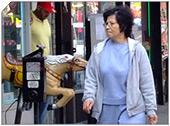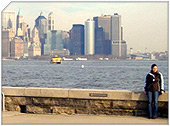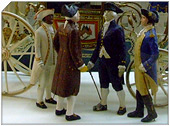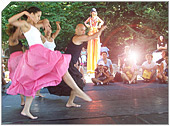SoHo, Manhattan, New York City
|
Getting Started
Index
NYC Neighborhoods
Manhattan
Brooklyn
Queens
Bronx
Staten Island
NYC Icons
Chrysler Building
Flatiron Building
Empire State Building
Safe NYC
NYPD
FDNY
NYC Weather
NYC Climate
NYC Weather Forecast
Winter Season
Spring Season
Summer Season
Fall Season
NYC History & Politics
New York City History
Tammany Hall and Politics
New York City Politicians
New York City Personalities
Culture of Gotham City
Culture of the city
Cultural diversity
City in popular culture
|
SoHo is a neighborhood in the New York City borough of Manhattan. It is bounded roughly by Houston Street on the north, Lafayette Street on the east, Canal Street on the south, and Varick Street on the west.
The name is an acronym for South of Houston Street, and has no relation to the Soho district of London, England. Its name has been the model for other new neighborhood descriptions in New York City, such as TriBeCa and DUMBO. Before its incarnation as a trendy locale, it was known as the Cast Iron District.
Historic district
As the artist population grew, the city made some attempts to stem the movement, especially concerned about the occupation of space that did not meet residential building codes, and the possibility that the space might be needed at some time for the return of manufacturing to New York City.
Pressured on many sides, the city eventually gave up on attempting to keep all of the Cast Iron District as industrial space, and the area received historical designation as SoHo.
The historic district is officially bounded by Houston Street, West Broadway, Canal Street and Crosby Street. It is noted for the elaborate cast-iron architecture of many of its buildings, most of which date from the late 19th century. These buildings originally housed warehouses and factories. It is also noted for its cobblestone streets, which have all recently been repaved with the exception of Crosby Street, Wooster Street, Mercer Street and part of Howard Street.
The neighborhood rose to fame as a neighborhood for artists during the 1960s and 1970s, when the cheap spaces vacated by departing factories were converted by artists into lofts and studios. SoHo's lofts were especially appealing to artists because they could use the wide spaces and tall ceilings that factories and warehouses required to create and store their work. During this period, which lasted into the 1980s, living in SoHo was often of dubious legality, as the area was zoned for light industrial and commercial uses rather than residential, and many residents had to convert their apartments into livable spaces on their own, with little money. However, beginning in the 1980s, in a way that would later apply elsewhere, the neighborhood began to draw more affluent residents. This led to an eventual exodus of the area's artists during the 1990s, leaving galleries, boutiques, restaurants, and young urban professionals behind.
SoHo's location, the appeal of lofts as living spaces, its architecture and, ironically, its "hip" reputation as a haven for artists all contributed to this change. The pattern of gentrification is typically known as the "SoHo Effect" and has been observed in several cities around the United States. Thirty years ago a backwater of poor artists and small factories, SoHo is now a popular tourist destination for people looking for fashionable (and expensive) clothing and exquisite architecture.
SoHo's boutiques and restaurants are clustered in the northern area of the neighborhood, along Broadway and Prince and Spring streets. The sidewalks in this area are often crowded with tourists and with vendors selling jewelry, t-shirts, and other works, sometimes leaving no space for pedestrians to walk. SoHo is known for its eclectic mix of different boutiques for shopping, including Prada, Chanel, popular skateboard/sneakerhead stores such as Supreme and Clientele, Kid Robot, and the newly established Apple Store. In recent years, however, more mundane chain stores have crept into SoHo, such as Bloomingdale's, H&M, Victoria's Secret, and J. Crew. SoHo has become fairly commercialized. Yet, the southern part of the neighborhood, along Grand Street and Canal Street, retains some of the feel of SoHo's earlier days and is less upscale and less crowded than the northern half. There are even a few small factories that have managed to remain. Canal Street at SoHo's south boundary contrasts with the former's posh shopping district in offering cheap imitation clothing and accessories.
|
New York City Search
Quick NYC
|
|
|
 How safe is New York City?
How safe is New York City? Contrary to popular belief, the City consistantly ranks in the top ten safest large cities in the United States. The NYPD is the largest municipal police force in the world and has it's own Movie/TV Unit. |

New York has a humid continental climate resulting from prevailing wind patterns that bring cool air from the interior of the North American continent. New York winters are typically cold with moderate snowfall.  New York Weather Forecast New York Weather Forecast |

New York's two key demographic features are its density and diversity. The New York City metropolitan area is home to the largest Jewish community outside Israel. It is also home to nearly a quarter of the nation's South Asians, and the largest African American community of any city in the country.  Ethnic composition Ethnic composition |

New York Newspapers
 
|



 New York Weather Forecast
New York Weather Forecast
 Ethnic composition
Ethnic composition


















